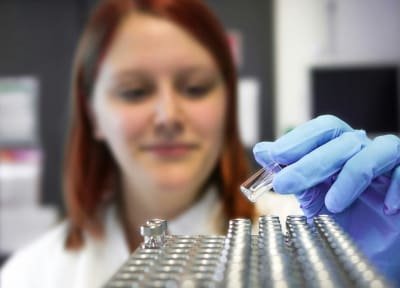Cancer Immunotherapy
Learn about the different types of cancer immunotherapy and how they are saving lives.
On This Page:
Overview
In recent years, one of the biggest breakthroughs in cancer treatment has come not from attacking cancer cells directly with drugs or radiation, but from empowering the immune system to fight cancer more effectively.
This approach, known as cancer immunotherapy, is the result of decades of research. By understanding how the immune system works—and how cancer can evade it—scientists have developed treatments that help the body recognize and attack cancer.
Immunotherapy has changed the outlook for many patients with cancers that were once hard to treat. Plus, it’s opening up new possibilities for long-term control, fewer side effects, and even cures.
Key Points
- Cancer immunotherapy uses the body’s own immune system to detect and destroy cancer cells more effectively.
- Major types include checkpoint inhibitors, CAR T cell therapy, cancer vaccines, and monoclonal antibodies, each working in different ways to support immune function.
- Immunotherapy has transformed treatment for several cancers—offering longer-lasting responses and new hope for patients with advanced disease.
How Does Immunotherapy Work?
The immune system is constantly scanning the body for abnormal or dangerous cells. But cancer can hide from, suppress, or confuse these defenses. Immunotherapy works by helping the immune system:
- Recognize cancer cells more clearly
- Respond and destroy cancer cells more effectively
- Overcome barriers that tumors use to hide from the immune system.
There are several types of immunotherapy, each using a different strategy to support or enhance immune function.
Checkpoint Inhibitors
Cancer cells often produce signals that turn off T cells (a type of immune cell). Checkpoint inhibitors block these cancer signals, allowing T cells to stay active and attack the cancer. These drugs target specific immune signals which normally act as “brakes” on the immune response. By inhibiting or blocking these molecules, checkpoint inhibitors can help the immune system work more effectively against cancer. Some comm checkpoint inhibitors in use today include:
- Pembrolizumab (Keytruda) – blocks a ‘brake’ molecule called PD-1. Pembrolizumab can be used to treat multiple cancers including melanoma, lung cancer, head and neck cancer, and breast cancer.
- Nivolumab (Opdivo) – also blocks PD-1. Nivolumab is approved for multiple cancers including kidney, bladder, and Hodgkin lymphoma.
- Ipilimumab (Yervoy) – blocks a ‘brake’ molecule called CTLA-4. Ipilimumab is often used in combination with nivolumab to treat melanoma, kidney cancer, bowel cancer, and more.
CAR T Cell Therapy
CAR T cell therapy is often referred to as a “living drug”. This is because CAR T cell therapy is a personalized treatment that genetically modifies a patient’s own T cells to better recognize and kill cancer cells.
Making these treatments begins with collecting blood from the patient and separating out the T cells. These cells are then sent to one of the treatment manufacturer’s laboratories, where they are genetically engineered to produce special proteins on their surfaces called chimeric antigen receptors, or CARs. The CARs help the cells to latch on to specific proteins, known as antigens, that are present on cancer cells (and some normal cells). They also enhance the T cells’ ability to kill cancer cells.
Next, these revamped T cells are grown, or “expanded,” until there are hundreds of millions of them. These expanded cells are the final CAR T cell therapy product, which is sent back to the hospital to be returned to the patient’s blood using an IV.
Currently, this entire process—from the initial blood collection to the cells being infused back into the patient—takes about 3 to 5 weeks.
After the infusion, if all goes as planned, the T cells will continue to expand in the patient’s body and, with guidance from their new receptors, kill any cancer cells that have the target antigen on their surfaces.
Cancer Vaccines
Unlike traditional vaccines that prevent infection, cancer treatment vaccines aim to treat cancer by training the immune system to recognize and respond to cancer-specific markers. In the same way that a vaccine is given to protect you against an infectious disease, these cancer vaccines expose the immune system to proteins found on cancer cells to stimulate an immune response.
Monoclonal antibodies
These lab-made antibodies can bind to specific targets on cancer cells and either destroy them directly or help the immune system recognize and kill them. Some monoclonal antibodies flag cancer cells for destruction; others carry toxic drugs or radioactive substances directly to the tumor. Some common monoclonal antibodies in use today include:
- Rituximab (Rituxan) – used for certain types of lymphoma and leukemia.
- Trastuzumab (Herceptin) – targets HER2-positive breast cancer.
- Atezolizumab (Tecentriq) – both a checkpoint inhibitor and monoclonal antibody.
Sources
- Jain, A., Marshall, J., Buikema, A., Bancroft, T., Kelly, J. P., & Newschaffer, C. J. (2015). Autism Occurrence by MMR Vaccine Status Among US Children With Older Siblings With and Without Autism. JAMA, 313(15), 1534. https://doi.org/10.1001/jama.2015.3077
- Taylor, B., Miller, E., Farrington, Cp., Petropoulos, M.-C., Favot-Mayaud, I., Li, J., & Waight, P. A. (1999). Autism and measles, mumps, and rubella vaccine: no epidemiological evidence for a causal association. The Lancet, 353(9169), 2026–2029. https://doi.org/10.1016/s0140-6736(99)01239-8
- Madsen, K. M., Hviid, A., Vestergaard, M., Schendel, D., Wohlfahrt, J., Thorsen, P., Olsen, J., & Melbye, M. (2002). A Population-Based Study of Measles, Mumps, and Rubella Vaccination and Autism. New England Journal of Medicine, 347(19), 1477–1482. https://doi.org/10.1056/nejmoa021134
Related Topics
Downloads
External Resources
Latest News


